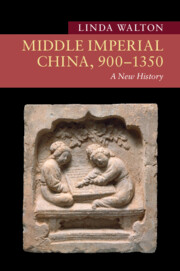Book contents
- Middle Imperial China, 900–1350
- New Approaches to Asian History
- Middle Imperial China, 900–1350
- Copyright page
- Dedication
- Contents
- Figures
- Maps
- Acknowledgments
- Introduction
- 1 The Turbulent Tenth Century
- 2 Song in a Multipolar World
- 3 Schooling, State, and Society in Song and Jin
- 4 An Economic Revolution?
- 5 Cities and Urban Life
- 6 Religious Transformations
- 7 Ways of Knowing
- 8 The Arts of Culture
- 9 Gendered and Generational Lives
- 10 Mapping the Built and Natural Environment
- 11 Sustaining Life and Healing Bodies
- 12 The Mongol Yuan Dynasty in China
- 13 Yuan China in the Mongol Eurasian Empire
- Bibliography
- Index
- New Approaches to Asian History
8 - The Arts of Culture
Published online by Cambridge University Press: 20 July 2023
- Middle Imperial China, 900–1350
- New Approaches to Asian History
- Middle Imperial China, 900–1350
- Copyright page
- Dedication
- Contents
- Figures
- Maps
- Acknowledgments
- Introduction
- 1 The Turbulent Tenth Century
- 2 Song in a Multipolar World
- 3 Schooling, State, and Society in Song and Jin
- 4 An Economic Revolution?
- 5 Cities and Urban Life
- 6 Religious Transformations
- 7 Ways of Knowing
- 8 The Arts of Culture
- 9 Gendered and Generational Lives
- 10 Mapping the Built and Natural Environment
- 11 Sustaining Life and Healing Bodies
- 12 The Mongol Yuan Dynasty in China
- 13 Yuan China in the Mongol Eurasian Empire
- Bibliography
- Index
- New Approaches to Asian History
Summary
What were the characteristics of a cultivated man and woman during the Song? Calligraphy, painting, and poetry comprised the visible and audible elements of cultivation that distinguished cultured persons from commoners. These art forms were often individualistic expressions of emotion and personal life, but they could also be used to convey veiled political and social commentary. How did public and private life find expression through cultural forms? How did visual and literary arts convey cultural, social, and even geographical identities? Women as well as men were painters and poets whose works can be used as sources for capturing features of social and cultural life otherwise absent from the historical record. Theater, opera, and storytelling were modes of cultural expression that extended across social boundaries and exhibited regional and ethnic differences as well. The development of drama during the Jin and Yuan eras provides a new source for understanding the intersection of elite and nonelite culture. Tomb artifacts representing theaters and performers as well as the texts of plays are sources that can be used to reconstruct elements of nonelite cultural forms. How did the spread of print technology contribute to the blurring of boundaries between elite and popular culture?
- Type
- Chapter
- Information
- Middle Imperial China, 900–1350A New History, pp. 191 - 216Publisher: Cambridge University PressPrint publication year: 2023



